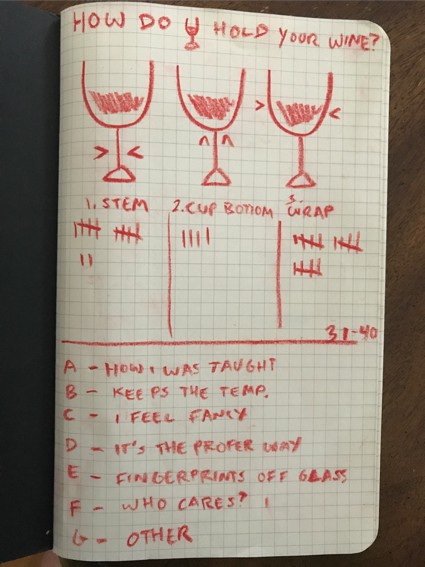The UX of Selecting the Right Wineglass.
Recently, friends and family unfamiliar with what I do and interested enough to find out have asked about the specifics of User Experience Design, User Interface Design, and Design Thinking. Having deployed the usual explanations and examples, walking them through my work and case studies, I found myself confronted by what at the time appeared to be a frustrating question but in retrospect has proved to be a fantastic opportunity to educate. “How can you apply this to real life? What use is UX strategy or Design Thinking outside a digital environment and digital products?” After giving a wealth of examples — from Organization Design in companies great and small, to employee activism borne out of belief in a business, product or service — I realized that what they were really asking me was, “how can I, me, the person asking this question employ UX principles and Design Thinking in my everyday life right now?”
Well, I’m glad you asked.
Do you like wine? Of course you do.
One summer I helped a friend who distributes wine and liquor to run several tasting events near my house. Essentially, I manned a table and poured drinks, extolling the virtue of the evening’s selections, bartending with a sales bent.
The first time I ran a wine tasting, I noticed that we were pouring various whites and reds into standard, plastic 9 oz. cups. The designer in me wondered if using those cups was the ideal experience for distributing and enjoying wine, particularly to wine enthusiasts. Aside from the divergent aesthetics (plastic vs glass, which I could understand from a cost-savings perspective; the distributor ran several tastings across the city during any given week), I’d often heard one should never hold a wine glass from the bottom, but rather hold by the stem or side to adequately swirl and ensure minimal temperature change to the wine. At home, I have several kinds of wine glasses — stemmed, tumblers, etc — multiple “user interfaces” for drinking wine. My question, as a sporadic wine drinker and host to a specific experience catered to qualified wine enthusiasts, then became a bit clearer.
I set an exercise for myself: cost not being an option, what would the best glass type (interface) be for my friend to offer his users at the next tasting (experience) — a stemmed container or one without, like a tumbler?

The event I was at catered to thirty tasters — highly qualified users with whom I could perform quick, guerrilla interviews — and I polled less qualified users across social media. I established several data sets by which I could gather information, understanding that the way they normally liked to hold a glass and why might inform the ideal result (of course, there are edge cases that could affect this study I did not take into account: users with arthritis who choose to drink, for instance, might need a firmer grasp on their glass; influence by a celebrity such as Oprah, endorsing a stemless tumbler in her Favorite Things ). I narrowed the sets to:
- Holding a glass by the stem
- Cupping a glass from the bottom; and
- Wrapping hand around the glass
Careful not to bring my personal preferences to the mix, I managed to survey 31 potential users (27 of the 40 at the event, 4 online), learning how they preferred to hold their wine and why — acquiring a specific range of grouped explanations listed below.
Armed with my data, I separated each holding preference and tallied the reasons why, then mapped the percentages within each grouping against 100% of its users:

I discovered that by far, the majority of users fell within data set 3, Wrapping, but mostly because the majority wasn’t invested or did not care. The next largest numbers of users fell with data set 1, Holding the Stem, and the majority reason there was one of a practical nature — holding a wineglass by the stem preserves the temperature of the wine and also keeps one’s fingerprints off the glass. That felt like a more telling data point that the majority of non-invested users. I took the tallied responses and organized the overall percentages into four main response groupings: Practical, Inherited (“This was how my father taught me to hold it”), Emotional (“I just feel this way about it, okay?”) and Not Invested (“Just pour, wine monkey!”):

Discounting the percentage of users who were not invested, and would drink the wine no matter how it was poured, this felt like a clear indication that most qualified users preferred a stemmed glass versus a tumbler, so that they could maintain temperature and perhaps leave their prints off the glass (this response could change depending on whether or not they got to keep said glass, of course). In addition, only one Inherited user had an emotional connection to data set 2, Cupping the Glass, but a stemmed glass could potentially satisfy all users: those from Set 1 could hold the stem, Set 2 users could still cup, and Set 3 users could wrap. A tumbler, conversely, would not be ideal for those in Set 1, specifically for the very important practical response and thereby could create a negative response in the end-user.
Of course, I did have the final deciding requirement to consider: keeping cost down. I did a little looking around and behold: a cost-effective stemmed “interface” that provides the means to hold a stem (for those to whom it’s important) while also being able to cup for those who find that a more natural way to hold their wine glass.

In the end, I realized my wine study had little to with identifying the best type of glass. It had more to do with employing UX skills and data to solve even for the mundane, commonplace experiences of my life. Whether in trying to decide on the best wineglass, choose the right car, or even figure out the best outfit to wear for a specific event, there’s an inherent (sometimes less involved) structure throughout: identifying a problem; gathering and measuring pertinent data; discovering and employing a correct solution based on external requirements and then iterating for the future.
- Identifying a problem in my life: What’s the best wine glass / Should I wear a suit or a polo to this meeting / The family needs a new car and I don’t know which to buy
- Discovery of how to solve the problem in my life: Let’s talk to qualified wine enthusiasts / what will other people be wearing to the meeting or have worn to meetings like it and how do I need to present myself / do I need the car for carpool or highway driving and are we having another child
- Solution to the problem in my life: The stem will keep my wine room temperature and those who want to cup can / a polo isn’t formal enough to meet with the CEO, Neil / Four kids won’t fit in a Mustang, or even the back of a roomy sedan (need four car seats in there!) so let’s go with the Town and Country or some other minivan
When we speak of Design Thinking, whether a designer, businessperson, housewife or what have you, I believe what we mean is using empathy and data to ask questions and create a plan, iterating upon it to solve a problem and make someone’s life better. The problems could range in perceived scale: they could be as large as conceiving a company’s new digital/mobile strategy, overhauling the way a business onboard new employees, but it also remains close to home, like trying to choose a new car, redecorate a room, or decide on the best wine glass.
Doing one’s best to understand human needs (even your own), to gather pertinent data and ask questions and then identify one or more potential solutions with the understanding that each person might interpret them differently (and potentially require iteration, polish and rewriting to achieve an intended goal) is not only at the root of design, but life itself.
When we speak of Design Thinking, whether a designer, businessperson, housewife or what have you, I believe what we mean is using empathy and data to ask questions and create a plan, iterating upon it to solve a problem and make someone’s life better...like trying to choose a new car, redecorate a room, or decide on the best wine glass.
Hopefully, now my friends and family have a better handle on how to — at even a basic level — arrive at more desirable experiences for their own lives and in their homes.
And if not…well, at least now they can enjoy a glass of wine under better, if not ideal conditions.